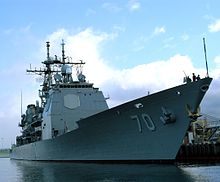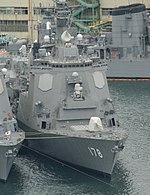AN/SPY-1
 The AN/SPY-1 radar antennas are the light grey octagonal panels on the front and starboard side of the superstructure of USS Lake Erie (CG-70). | |
| Country of origin | United States |
|---|---|
| Introduced | 1973 |
| Type | 3D Air search |
| Frequency | S band[1] |
| Range | 100+ nm[2] |
| Azimuth | 0–360° |
| Elevation | Horizon–zenith[3] |
| Power | 6 MW |
The AN/SPY-1[a] is a US naval radar system manufactured by Lockheed Martin. The array is a passive electronically scanned system and is a key component of the Aegis Combat System. The system is computer controlled, using four complementary antennas to provide 360 degree coverage. The system was first installed in 1973 on the USS Norton Sound and entered active service in 1983 as the SPY-1A on USS Ticonderoga. The -1A was installed on ships up to CG-58, with the -1B upgrade first installed on Princeton in 1986. The upgraded -1B(V) was retrofitted to existing ships from CG-59 up to the last, CG-73.
Description
The first production model of SPY-1 series is SPY-1, forms the baseline configuration of all subsequent SPY-1 radars. SPY-1A has four antenna arrays in two separate deckhouses, with each antenna array containing 148 modules.[5] Each module contains up to 32 radiating element and phase shifters, and modules are paired to form transmitting and receiving sub-arrays, which are grouped into 32 transmitting and 68 receiving arrays.[5] Transmitting arrays are driven by eight transmitters, each with four Crossed-field amplifiers (CFAs), and each CFA produces a peak power of 132 kW.[5] There are a total of 4096 radiators, 4352 receivers and 128 auxiliary elements on each antenna array.[5] The power requirement of SPY-1A is four times that of AN/SPS-48 and SPY-1 is controlled by AN/UYK-7 computer.[5]
SPY-1A upgrade is a development of SPY-1, resulting from the deployment of SPY-1 equipped USS Ticonderoga off Lebanese coast. It was discovered that the false alarm rate was high because the radar would pick up swarms of insects and clutter from mountainous terrain. The solution is to allow operator to change sensitivity profile of radar by periodically reduce attenuation, and to set threat and non threat sectors according to change of environment.[5] The result is more efficient utilization of resources and around 10% of the software totaling thirty thousand lines had to be rewritten to accommodate the necessary upgrade.[5]
SPY-1B is the model adopts VLSI resulting in increased performance and reduced size and weight. For example, the electronic cabinets area reduced from 11 to 5, with corresponding weight reduced from 14700 lb to 10800 lb, and separate digital modules are reduced from 3806 to 1606.[5] 7-bit phase shifter replaced the 4-bit phase shifter in earlier models, with corresponding weight of phase shifters in face of the antenna reduced from 12000 lb to 7900 lb, and a reduction of side lobe by 15 dB.[5] There are 4350 radiators with two side lobe cancellation antenna, each with two elements, and the radar uses eleven 16-bit microprocessors.[5] Ability to counter steep diving missiles are improved with more energy at higher elevation or longer pulse.[5]
SPY-1B(V) is development of earlier SPY-1B with moving target indication capability incorporated in 1997.[5]
SPY-1D was first installed on Arleigh Burke in 1991, with all antenna in a single deckhouse. It is a variant of the -1B to fit the Arleigh Burke class using UKY-43 computer, with the main antenna also used as missile uplinks, thus eliminate the need of separate missile uplink in earlier models, and the UYA-4 display in earlier models is replaced by UKQ-21 display.[5]
SPY-1D(V), the Littoral Warfare Radar, was an upgrade introduced in 1998 with new track initiation processor for high clutter near-coast operations, where the earlier "blue water" systems were especially weak. The wave form is coded and signal processing is improved.[5]
SPY-1E SBAR (S Band Active Array) is the only active phased array model in SPY-1 series, and it was later renamed as SPY-2, subsequently developed into VSR. SPY-1E utilizes commercial off-the-shelf (COTS) subsystems and a single faced demonstration unit was built in 2004. The weight of antenna remains the same but weight below deck is greatly reduced.[5]
SPY-1F FARS (frigate array radar system) is a smaller version of the 1D designed to fit frigates. It is not used by the US Navy, but has been exported to Norway. The origin of the SPY-1F can be traced back to the FARS proposed to the German Navy in the 1980s. The size of the antenna of SPY-1F is reduced from the original 12 ft with 4350 elements to 8 ft with 1856 elements, and the range is 54% of the SPY-1D.[5]
SPY-1F(V) is a derivative of SPY-1F with improved capability against littoral targets and cruise missiles, with better multi-mission capability.[5]
SPY-1K is the smallest version of the radar currently offered, based on the same architecture as the 1D and 1F. It is intended for use on very small vessels such as corvettes, where the SPY-1F would be too large. The size of the antenna is further reduced to 5 ft with 912 elements.[5] As of 2007, none are in service, although the radar is incorporated into the design of the yet-unbuilt AFCON Corvette.[6][7]
Variants
- AN/SPY-1: Prototypes, USS Norton Sound (AVM-1).
- AN/SPY-1A: Ticonderoga-class cruisers up to CG-58.
- AN/SPY-1B: Ticonderoga-class cruisers starting at CG-59. 12 foot diameter.[8]
- AN/SPY-1B(V): Upgrade to -1B version, retrofitted to CG-59 and up.
- AN/SPY-1D: Variant of -1B designed for Arleigh Burke-class destroyers, JDS Kongō-class destroyers and Spanish Armada Álvaro de Bazán-class frigates.
- AN/SPY-1D(V): Littoral Warfare Radar upgrade to the -1D variant for DDG 51 Flight IIA, JDS Atago-class destroyers, ROKN King Sejong the Great-class destroyer (KDX-III) and Spanish Armada F-105 frigate.
- AN/SPY-1F: Smaller version of the -1D designed to fit frigates. Installed on the RNoN Fridtjof Nansen-class frigates. 8 foot diameter.
- AN/SPY-1K: Smallest version of the radar offered, intended to fit corvette-sized vessels. None currently in service.
Specification
The following specification apply to SPY-1A/B/D series.[5]
- Size: 12 ft octagon
- Weight above deck (lb): 13,030 per face
- Weight below deck (lb):131,584
- Range (nm): 175, 45 against sea-skimming missiles
- Targets simultaneously tracked: 200 each array, 800 total.
- Band: S band (3.1 – 3.5 GHz)
- Sustained coherent bandwidth (MHz): 10
- Instantaneous bandwidth (MHz): 40
- Beam (º): 1.7 x 1.7
- Peak power (MW): 4 – 6
- Average power (kW): 58
- Gain (dB):42
- Pulse width (microsecond): 51, 25.4, 12.7, & 6.4
- Pulse compression ratio: 128:1
- PRF: variable
- Scan rate (scan/min): 1 (horizon), 12 (above horizon)
Operators

 Australia: Hobart-class destroyer, expected commissionings starting 2014[9]
Australia: Hobart-class destroyer, expected commissionings starting 2014[9] Japan: Kongō-class destroyers, Atago-class destroyers
Japan: Kongō-class destroyers, Atago-class destroyers Norway: Fridtjof Nansen–class frigate
Norway: Fridtjof Nansen–class frigate Spain: Álvaro de Bazán–class frigate
Spain: Álvaro de Bazán–class frigate South Korea: King Sejong the Great–class destroyer (KDX-III)
South Korea: King Sejong the Great–class destroyer (KDX-III) United States: Ticonderoga-class cruiser, Arleigh Burke–class destroyer
United States: Ticonderoga-class cruiser, Arleigh Burke–class destroyer
Air and Missile Defense Radar
In July 2009, Lockheed Martin was one of three companies awarded contracts to study the development of a new Air and Missile Defense Radar (AMDR) to be composed of an S-Band radar, an X-Band radar and a Radar Suite Controller to defend against evolving anti-ship and ballistic missile threats.[10]
See also
Notes
- ^ Army Navy Joint Electronics Type Designation System / S - Water (surface ship), P - Radar, Y - Surveillance (target detecting and tracking) and Control (fire control and/or air control), model number[4]
References
- ^ [1][dead link]
- ^ Integrated Publishing. "Optronics Sysyems". Tpub.com. Retrieved 2010-08-19.
- ^ "CG 47 CLASS ADVISORY NR. 04-97, HERP-HERO GUIDANCE". Fas.org. 2008-05-30. Archived from the original on 21 August 2010. Retrieved 2010-08-19.
{{cite web}}: Unknown parameter|deadurl=ignored (|url-status=suggested) (help) - ^ Joint Electronics Type Designation System
- ^ a b c d e f g h i j k l m n o p q r s Norman Polmar. The Naval Institute Guide to World Naval Weapon Systems, 5th Edition: SPY-1/FARS. Annapolis, Maryland: Naval Institute Press. May 24, 2006. ISBN 978-1557502629. pp. 316–317.
- ^ http://www.afconships.com/products.html
- ^ [2][dead link]
- ^ "LockMart brochure" (PDF). Retrieved 2012-01-12.
- ^ "All 4 SPY-1 Radar Arrays installed on Royal Australian Navy Hobart Class Air Warfare Destroyer". December 18, 2014.
- ^ "LockMart Develop Concept For New US Navy Air And Missile Defense Radar". Spacewar.com. Retrieved 2010-08-19.
